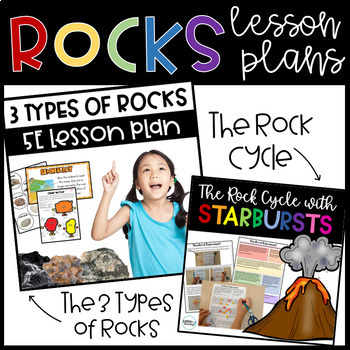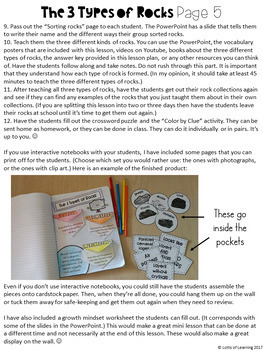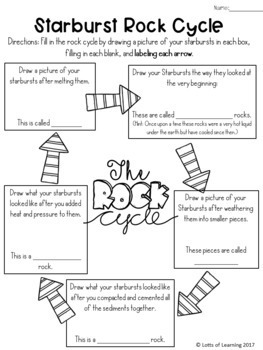Three Types of Rocks & The Rock Cycle 5E Science Lessons with Worksheets
- Zip
What educators are saying
Products in this Bundle (2)
Description
Are you looking for a fun way to teach the three types of rocks (igneous, sedimentary, and metamorphic) and the rock cycle? Well, look no more! This bundle includes two engaging and hands-on lesson plans that use the 5E model to teach the 3 types of rocks and the rock cycle. Please click the preview where you can view every single page of both these lesson plans.
Please note that this is a BUNDLE of two products. By purchasing them together, you save 20%! This bundle includes the following products (both of which are 5E science lesson):
1.The Three Types of Rocks Lesson Plan with PowerPoint
2.The Rock Cycle with Starbursts
ROCKS AND MINERALS UNIT
These two lesson plans are also part of my HUGE Rocks and Minerals Unit. If you are looking for 3 weeks worth of material that you can use to teach an entire rocks and minerals unit, then check out the unit.
1. THREE TYPES OF ROCKS LESSON PLAN
This 5E lesson begins with an ENGAGING activity where students sort their own rock collections from home with peers. They choose the categories they sort them into. The teacher walks around and tries to guess how each group has sorted their rocks. After the activity, students EXPLORE the different ways that rocks can be sorted. The teacher tells them that geologists can sort all rocks into 3 categories and asks the students if they know what those 3 categories are. The teacher guides them into responding with he 3 types of rocks: igneous, sedimentary, and metamorphic. The teacher uses the PowerPoint to EXPLAIN the 3 different kinds of rocks and the students take notes. After learning about the 3 types of rocks, students ELABORATE their understanding by pulling out their rock collections again and seeing if they can find any of the rocks they just learned about. To EVALUATE the students' understanding of the 3 types of rocks, a crossword puzzle and a coloring activity are provided.
THE POWERPOINT
This PowerPoint uses kid-friendly definitions, lots of visuals to explain how each rock forms, photographs of each rock, and explanations of how each rock is used in every day life to teach the 3 types of rocks. While going through the PowerPoint, students can take notes in a differentiated note-taking page (one graphic organizer is completely blank, while the other graphic organizer has fill-in-the-blanks for those that struggle with writing). All of the answers they need to write down are in the PowerPoint, making it so you can walk around and facilitate while they take notes.
ASSESSMENTS
To assess the student's understanding of the 3 types of rocks, I have included a crossword puzzle and a coloring page. The crossword puzzle assess their knowledge of the vocabulary words they just learned. The coloring activity assesses their knowledge on everything they just learned, but in a fun way. Students read the clues on the picture and if the clue is referring to an igneous rock, they color it red. If the clue is referring to a sedimentary rock, they color it orange. And if the clue is referring to a metamorphic rock, they color it yellow. Answer keys are provided for both assessments. These assessments can be used in class or as homework.
INTERACTIVE NOTEBOOK PAGES
If you use interactive notebooks in your class, I have provided some fun pockets that the students can add to their notebooks. There are three pockets, one for each type of rock (igneous, sedimentary, and igneous.) The students glue the pockets to their interactive notebooks and then sort the different rocks and characteristics and keep them in the pockets. You can see an example of the finished product in the preview.
GROWTH MINDSET MINI LESSON
Metamorphic rocks are formed when existing rocks undergo heat and pressure. What once was a dull rock grows beautiful crystals. What once was a fragile rock becomes hard and durable. In a way, we are all kind of like sedimentary rocks striving to become metamorphic rocks. To become a metamorphic rock, we need to embrace heat and pressure, rather than run from it. Having a GROWTH MINDSET helps us do that. This mini lesson encourages students to think of something in their life that is causing them a lot of heat and pressure. They write why it is difficult and then sign their name, pledging to embrace it with a growth mindset because they know it will make them stronger, like a metamorphic rock.
2. THE ROCK CYCLE WITH STARBURSTS LESSON PLAN
Students ENGAGE in a Starburst Experiment not knowing they are doing the rock cycle. (This leaves room for an "ah-ha" moment later.) They just follow the instructions in front of them and draw pictures as they go. First, they unwrap their Starbursts and cut them into pieces. Then they press those pieces together with their hands and pretend like they are doing it under water. While they are pressing the pieces together, they say, "Compaction and compression" over and over. After their pieces have been thoroughly pressed together, they place them in a baggie and use the heat of their hands, and pressure, to morph the Starbursts into a new shape. Then their Starbursts go in the microwave where they melt, and then back out to cool. A classroom discussion follows, where the students EXPLORE what was done to their Starbursts. They eventually realize that their Starbursts just went through the rock cycle! Then you EXPLAIN the rock cycle even more by displaying my eye-catching rock cycle poster(s). (For example, it's not always just one continuous circle). Vocabulary posters are also provided so that you can successfully further explain each step of the rock cycle. After the rock cycle has been explained, this lesson challenges students to ELABORATE their understanding by having them fill out a worksheet. This worksheet has them draw their Starbursts again, but this time they label each step with its corresponding part of the rock cycle. To EVALUATE the students' understanding of the rock cycle, a blank rock cycle is provided, as well as an answer key. If you're looking for a way to evaluate their understanding that also incorporates NARRATIVE WRITING then you can use the "Rock Cycle Story" materials that I have included.
VOCABULARY POSTERS
This bundle includes many different vocabulary posters that can be used throughout these lessons. They are perfect for hanging up on the wall so that students can frequently refer to them throughout your lesson or unit. There are posters for the following terms: geologist, rock, mineral, lava, magma, intrusive igneous rock, extrusive igneous rock, igneous rocks, sedimentary rocks, and metamorphic rocks. There are also posters that display photographs of each type of rock. There are many different designs and definitions to choose from.
ROCK CYCLE POSTERS
There are many different rock cycle posters to choose from. Some include clip art, while some include actual photographs. There are many designs to choose from.
Here is everything that you're getting with this product: (please click the preview so you can see the quality of my work):
-A detailed lesson plan to teach the three types of rocks
-A page that explains how the three types of rocks lesson follows the 5E model
-A PowerPoint that you can use to teach the three types of rocks
-Differentiated graphic organizers that go along with the PowerPoint. Students fill it out while learning about the three types of rocks
-A crossword puzzle that can be used as an assessment
-A coloring activity to assess their knowledge of the three types of rocks
-Interactive Notebook pages where students sort the names of rocks and characteristics in the correct category
-Growth mindset pages that the students can fill out. After filling them out, they sign their name, pledging to embrace the heat and pressures of life with a growth mindset
-A detailed lesson plan to teach the rock cycle
-A page that explains how the rock cycle lesson follows the 5E Model
-Detailed instructions that the students read and fill out while they do the Starburst experiment
-A set of instructions with pictures that could be used for ELLs
-A flowchart that the students fill out to elaborate their understanding of the rock cycle (an answer key is provided)
-A blank rock cycle worksheet and answer key that can be used as an assessment
-A rock cycle practice page (students fold it in half, fill it out, and then unfold it to check their answers.)
Together, these lesson plans are aligned with the following standards:
CCSS Alignment:
CCSS.ELA-LITERACY.W.4.3 Write narratives to develop real or imagined experiences or events using effective technique, descriptive details, and clear event sequences.
NGSS Alignment:
4-ESS1-1. Identify evidence from patterns in rock formations and fossils in rock layers to support an explanation for changes in a landscape over time.
MS-ESS2-1.
Develop a model to describe the cycling of Earth's materials and the flow of energy that drives this process.
MS-ESS2-2. Construct an explanation based on evidence for how geoscience processes have changed Earth’s surface at varying time and spatial scales
And Utah SEEd Standard 7.2.1 Develop a model of the rock cycle to describe the relationship between energy flow and matter cycling that create igneous, sedimentary, and metamorphic rocks.
You might also be interested in:
A lesson that you can use to introduce your rocks and minerals unit. It teaches the difference between a rock and a mineral.
Two lesson plans that teach about the properties of minerals.
Rocks and Minerals Study Guide and Test
I have used this test for 3 years, and it each year the students that did well on my test, did well on the rocks and minerals portion of the SAGE test. It also comes with a review game.
© Lotts of Learning





